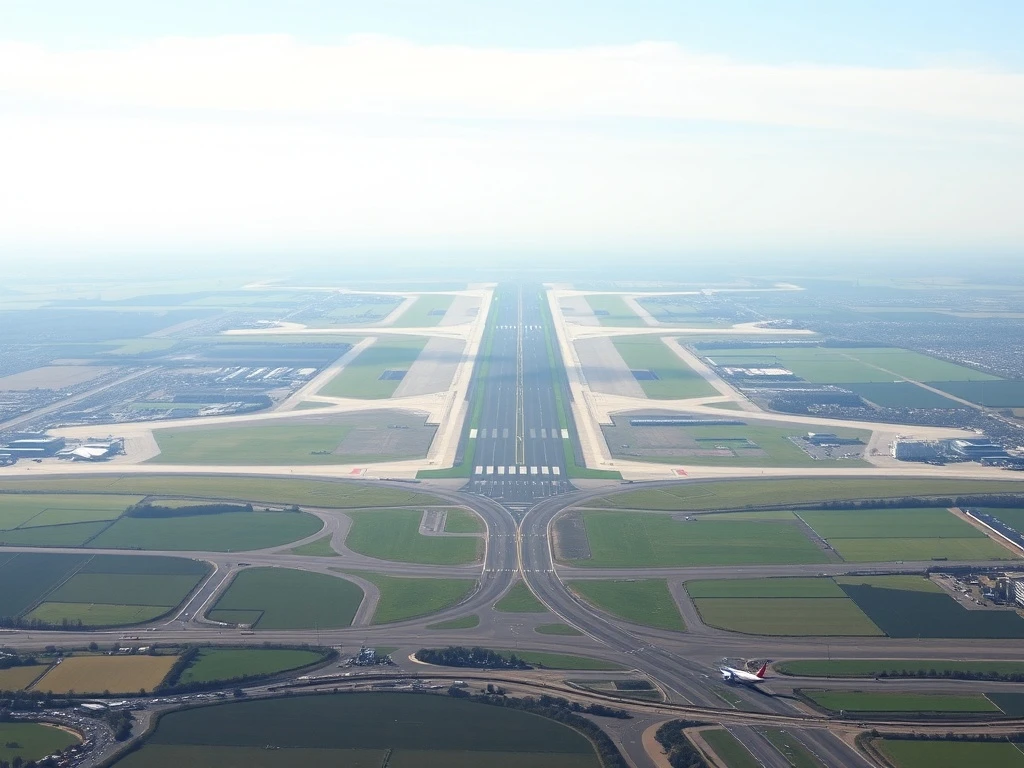Heathrow Airport has unveiled a transformative £21 billion plan for a third runway. This ambitious project aims for completion by 2039. It signals a major push for UK air travel capacity. This significant investment will reshape Britain’s aviation landscape. It also promises substantial economic benefits.
The Ambitious Heathrow Third Runway Proposal
Heathrow Airport officially submitted its updated plans for a third runway on August 1, 2025. The revised cost stands at £21 billion. This marks a notable increase from the £14 billion estimate in 2018. Construction inflation and growing passenger demand are cited as key reasons for this rise. The proposal details a new 3,500-metre runway. It will be located to the north-west of the existing airport site. However, the airport also remains open to considering a shorter alternative. This could potentially reduce both costs and complexity. This flexibility shows a pragmatic approach to the project’s scale.
The expansion aims to significantly boost Heathrow’s operational capacity. It would enable the airport to accommodate an additional 276,000 flights annually. This increases total capacity from 480,000 to 756,000 flights per year. Furthermore, Heathrow plans to raise passenger capacity. It will grow from 84 million to 150 million passengers annually. This massive increase requires substantial terminal infrastructure redevelopment. New terminals T5XW and T5XN are planned. Terminal 2 will also see an extension. Meanwhile, Terminal 3 and the now-defunct Terminal 1 face demolition. This comprehensive overhaul prepares Heathrow for future demands.
Driving Economic Growth and Connectivity
Heathrow’s chief executive, Thomas Woldbye, emphasized the urgent need for expansion. “It has never been more important or urgent to expand Heathrow,” he stated. He highlighted the airport’s current operational limits. “We are effectively operating at capacity to the detriment of trade and connectivity.” This expansion, therefore, represents a vital step. It aims to unlock significant economic opportunities for the UK. The project is projected to create up to 100,000 jobs. These jobs would span various sectors, from construction to aviation services. Additionally, it would boost investment across the country’s supply chain. This comprehensive plan supports national economic recovery.
The proposed Heathrow third runway would enhance Britain’s global trade links. Increased flight capacity means more routes and greater cargo movement. This directly benefits businesses involved in international trade. Chancellor Rachel Reeves voiced strong support for the project. She noted, “We are one step closer to expanding our biggest airport – boosting investment in Britain, increasing trade for businesses, and creating up to 100,000 jobs.” Transport Secretary Heidi Alexander echoed this sentiment. She welcomed the proposals as “a significant step towards unlocking growth, creating jobs, and delivering vital national infrastructure.” Such backing underscores the government’s belief in the project’s economic merits.
Navigating Infrastructure Challenges and Funding
Implementing the Heathrow third runway plan involves significant infrastructure challenges. A major hurdle includes rerouting the M25 motorway. It would need to pass through a tunnel beneath the proposed runway. This is a complex engineering feat. It requires careful planning and execution. The airport believes it can secure planning consent by 2029. The new runway could then become operational within the following decade. This timeline allows for detailed design and construction phases. The project will be privately funded. However, the total cost, including terminals and associated infrastructure, is expected to reach £49 billion. This substantial investment highlights the project’s scale and ambition. It also necessitates a robust financial model.
The private funding model raises questions about its impact on airport charges. Budget airline easyJet, which currently does not operate from Heathrow, welcomed the expansion. CEO Kenton Jarvis stated it offers a “unique opportunity” for the airline. It could serve the airport at scale and bring lower fares to consumers. However, other airline operators have voiced concerns. They worry about potential increases in passenger charges. Such increases might be used to fund the expansion. Conservative shadow transport secretary Richard Holden also added a note of caution. He welcomed private investment. Yet, he warned, “There can be no backup blank cheque from taxpayers. Britain needs infrastructure that is affordable, accountable and ambitious.” This highlights the need for a transparent and fair regulatory model.
Environmental and Local Opposition to Heathrow Third Runway
Despite the economic arguments, significant opposition to the Heathrow third runway persists. Mayor of London Sadiq Khan has long opposed the project. He reiterated his firm stance. “I remain firmly against a third runway at Heathrow because of the severe impact it will have in terms of noise, air pollution and meeting our climate change targets,” he stated. His concerns reflect broader environmental anxieties. Increased flights inevitably lead to higher carbon emissions. This poses a challenge to the UK’s net-zero goals. Local communities also face potential increases in noise pollution and worsened air quality. These factors directly affect residents’ health and well-being.
Environmental groups also echoed these concerns. Tony Bosworth, a climate campaigner at Friends of the Earth, issued a stark warning. “If Prime Minister Sir Keir Starmer wants to be seen as a climate leader, backing Heathrow expansion is the wrong move,” he cautioned. This emphasizes the conflict between economic growth and environmental protection. The debate often centers on whether technological advancements, like sustainable aviation fuels, can mitigate the environmental impact of increased air travel. Critics argue that relying solely on future technologies is insufficient. They advocate for immediate action to reduce emissions. This includes limiting airport expansion. Therefore, the environmental implications remain a central point of contention for the Heathrow third runway.
Alternative Visions and Regulatory Pathways
The announcement of Heathrow’s revised plan coincided with a rival proposal. Hotel magnate Surinder Arora’s Arora Group put forward an alternative. Their plan suggests a shorter, 2,800-metre runway. Crucially, this design would avoid moving the M25 motorway. It aims to reduce risk and cut costs significantly. This alternative provides a different perspective on how to expand Heathrow’s capacity. It highlights the complexities and varying approaches to major infrastructure projects. The existence of competing proposals underscores the importance of thorough review. It ensures the chosen path offers the best balance of benefits and costs for the nation.
The next stage for Heathrow’s plan involves a summer review. This review focuses on the Airports National Policy Statement (ANPS). The ANPS will form the basis for any future development consent order application. This governmental process is crucial. It determines the legal and policy framework for major airport developments. The government’s current backing for the revised Heathrow expansion plan appears strong. However, the rigorous review process will scrutinize all aspects. Ministers, business leaders, and environmentalists are preparing for another high-stakes decision. This decision will occur against a backdrop of economic recovery efforts and ambitious net-zero goals. The future of the Heathrow third runway ultimately depends on this critical regulatory pathway.
Conclusion
Heathrow Airport’s £21 billion third runway plan represents a bold vision for UK aviation. It promises significant economic benefits, including job creation and enhanced trade links. However, it also faces substantial challenges. These include complex infrastructure demands and strong environmental opposition. The debate over this expansion is long-standing. It now reopens with renewed urgency. Stakeholders across the spectrum are weighing the costs and benefits. The government’s review of the Airports National Policy Statement will be pivotal. Ultimately, the decision on the Heathrow third runway will shape Britain’s connectivity and environmental commitments for decades to come. It requires careful consideration of all perspectives.
Frequently Asked Questions (FAQs)
What is the estimated cost of the Heathrow third runway project?
The updated plan for the Heathrow third runway is estimated to cost £21 billion. This figure is up from an earlier estimate of £14 billion in 2018. The total project cost, including new terminals and infrastructure, could reach £49 billion.
When is the Heathrow third runway expected to be completed?
Heathrow Airport aims to secure planning consent by 2029. The new third runway is then projected to be operational within the following decade, potentially by 2039.
How will the Heathrow third runway expansion affect flight and passenger capacity?
The expansion would enable Heathrow to accommodate 276,000 additional flights annually. This increases total flight capacity from 480,000 to 756,000 flights per year. Passenger capacity is also planned to rise from 84 million to 150 million per year.
What are the main concerns raised about the Heathrow third runway?
Key concerns include potential increases in noise pollution and air pollution for surrounding communities. Environmental groups also worry about the project’s impact on climate change targets due to increased carbon emissions from more flights. Additionally, some airlines have expressed concern over potential increases in passenger charges to fund the expansion.
Is there an alternative proposal to the Heathrow third runway plan?
Yes, hotel magnate Surinder Arora’s Arora Group has proposed a shorter, 2,800-metre runway. This alternative design would avoid the complex and costly rerouting of the M25 motorway, aiming to reduce overall risk and expense.
























